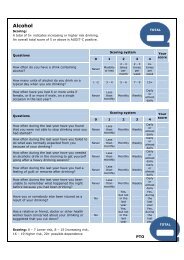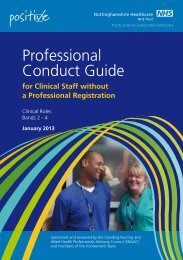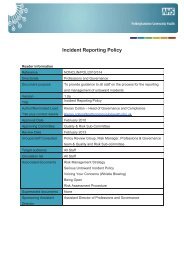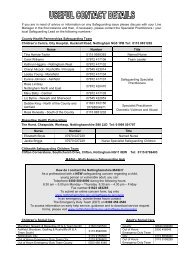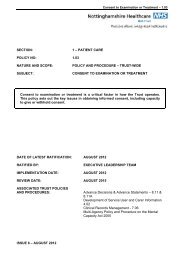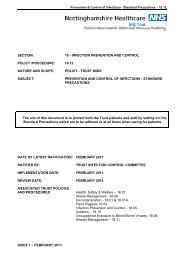Serious Untoward Incident Policy - Health Partnerships Learning ...
Serious Untoward Incident Policy - Health Partnerships Learning ...
Serious Untoward Incident Policy - Health Partnerships Learning ...
You also want an ePaper? Increase the reach of your titles
YUMPU automatically turns print PDFs into web optimized ePapers that Google loves.
Coronial Law – request for reports for the Coroner and witnessappearances at InquestsCoroners are required to inquire into deaths reports to them, which appear to be violent, unnatural, orof sudden and unknown cause. The Coroner will seek to establish the medical cause of death; if thecause remains in doubt after a post mortem, an inquest will be held. Not all deaths are reported to thecoroner. In many cases a GP or hospital doctor can certify the medical cause of death and the deathcan be registered by the Registrar of Births and Deaths in the usual way. However, these Registrarsmust report deaths to the Coroner in certain circumstances. For example if a doctor cannot give asatisfactory cause of death; if the death occurred during or shortly after an operation; was due toindustrial disease; occurred whilst the person was in custody, or if the death was unnatural or due toviolence or occurred in other suspicious circumstances.An Inquest is an inquiry into who has died and how, when and where the death occurred and morerecently the addition of “and in what circumstances the death occurred” has been added. An inquestis not a trial and does not apportion blame for a death. Possible verdicts include: natural causes,accident, suicide, unlawful or lawful killing, industrial disease and open verdicts (where there isinsufficient evidence for any other verdict) or if death is as a result of neglect. The Coroner may bringa narrative verdict, in which case additional text will be included in the verdict.General Principles: The Coroner will expect a report within a certain timescale, usually within 28 days of thewritten request. If in any doubt about the amount of detail required in a report, contact the Head ofGovernance for advice. The report should be capable of standing on its own. Do not assume that the reader has anybackground knowledge of the case. Several people may have to read the report from theCoroner. A draft of the report should be sent to the Head of Governance before a signed copyis sent to the Coroner. Remember that the Coroner may not be a clinician so the report should be written so that alay person can understand it; i.e. drug names, doses etc in full, what it was prescribed for,when started or stopped and why.Clinical Records:The Coroner may require disclosure of the whole medical record. In any event, take a fullphotocopy set, including the front and back cover of the Lloyd George envelope if appropriate(even if the back has nothing written on it), for your own records before disclosing or returningthe records. Also keep a printout of all information held on computer.You may need to keep copies before destroying them in accordance with NCH Retention andDisposal schedules. (Refer to Records Management Code of Practice part 2)It can be helpful to give the exact dates spanned by the notes because it will not always beobvious from the entries.Style of report: Avoid using any abbreviations in your report, unless the meaning is written out in full on firstusage. If you mention a drug, explain what type of drug it is, give the full generic name,dosage, method of administration, when started or stopped and why it was prescribed orstopped. Write your report in the first person. It is tempting to write in the passive tense because that isthe accepted format in a clinical report. However, it is easier for the Coroner to get the fullpicture of events if the report is written in the first person.First hand evidence: The Coroner is most interested in first hand evidence. Hearsay evidence carries less weight.Concentrate on your observations and understanding of the case, provide factual evidencenot supposition.25



